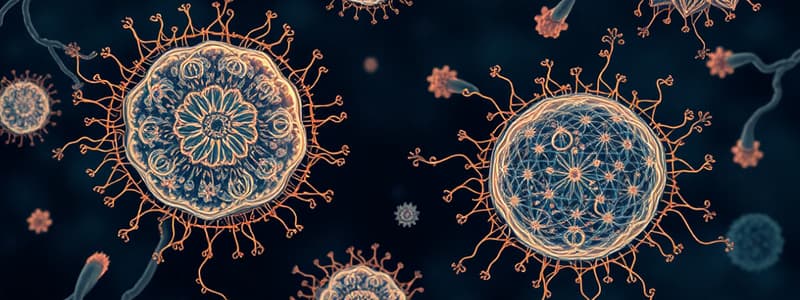Podcast
Questions and Answers
What is a key characteristic that distinguishes eukaryotic cells from prokaryotic cells?
What is a key characteristic that distinguishes eukaryotic cells from prokaryotic cells?
- Presence of a nucleus (correct)
- Size of the cell
- Presence of a cell wall
- Ability to reproduce sexually
Which of the following organisms is classified as a prokaryote?
Which of the following organisms is classified as a prokaryote?
- Plants
- Humans
- Fungi
- Bacteria (correct)
Which structure is NOT found in prokaryotic cells?
Which structure is NOT found in prokaryotic cells?
- Nucleus (correct)
- Cytoplasm
- Ribosomes
- Cell membrane
Which of the following options correctly describes eukaryotic cells?
Which of the following options correctly describes eukaryotic cells?
Which of the following groups includes organisms made up of eukaryotic cells?
Which of the following groups includes organisms made up of eukaryotic cells?
What is a primary focus of microbial biotechnology in the food industry?
What is a primary focus of microbial biotechnology in the food industry?
Which of the following best describes the role of microbial processes in food production?
Which of the following best describes the role of microbial processes in food production?
How does microbial biotechnology contribute to sustainable food practices?
How does microbial biotechnology contribute to sustainable food practices?
What is a significant biotechnological advancement in the food industry?
What is a significant biotechnological advancement in the food industry?
What is an ethical concern associated with biotechnological applications in the food industry?
What is an ethical concern associated with biotechnological applications in the food industry?
Acidity (pH) is considered an intrinsic factor affecting microbial activity in food.
Acidity (pH) is considered an intrinsic factor affecting microbial activity in food.
The storage conditions of food are classified as intrinsic factors that influence microbial activity.
The storage conditions of food are classified as intrinsic factors that influence microbial activity.
Both intrinsic and extrinsic factors play a role in microbial activity within food.
Both intrinsic and extrinsic factors play a role in microbial activity within food.
Temperature is an intrinsic factor that influences microbial growth.
Temperature is an intrinsic factor that influences microbial growth.
Intrinsic factors are determined by the composition of the food itself.
Intrinsic factors are determined by the composition of the food itself.
The mitochondria is often referred to as the 'powerhouse' of the cell because it is involved in respiration.
The mitochondria is often referred to as the 'powerhouse' of the cell because it is involved in respiration.
The nucleus is the cell structure that contains the cell's ribosomes.
The nucleus is the cell structure that contains the cell's ribosomes.
The 'daughter' cell splits off from the 'mother' cell during the process of cell division.
The 'daughter' cell splits off from the 'mother' cell during the process of cell division.
The nuclear membrane encloses the mitochondria in a cell.
The nuclear membrane encloses the mitochondria in a cell.
Cells with a nuclear membrane are classified as prokaryotic.
Cells with a nuclear membrane are classified as prokaryotic.
Flashcards are hidden until you start studying
Study Notes
Prokaryotic and Eukaryotic Cells
- Prokaryotic cells lack a nucleus and membrane-bound organelles.
- Eukaryotic cells have a nucleus and membrane-bound organelles.
- Two main types of cells are prokaryotes and eukaryotes.
Prokaryotes
- Bacteria are prokaryotes.
Eukaryotes
- Plants, fungi, animals, and humans are eukaryotes.
Cytoplasm
- The cytoplasm of a bacterial cell is the site of growth, metabolism, and replication.
Ribosomes
- Ribosomes are tiny factories that translate genetic code from nucleic acids to amino acids, which are the building blocks of proteins.
Pruteen
- Pruteen is made from the bacterium Methilophilus methilotrophus.
Spirulina
- Spirulina is a cyanobacteria from the genus Arthrospira.
- Spirulina is available as whole cells and beta carotenes.
Daughter Cell
- A new cell that forms from an original cell, referred to as the "mother" cell.
Mitochondria
- Known as the "powerhouse" of the cell.
- The site where respiration occurs.
Nucleus
- Contains DNA, the genetic material of the cell.
Nuclear Membrane
- The membrane that surrounds the nucleus.
Factors Governing Microbial Activity In Food
- Intrinsic Factors: Attributes of the food itself.
- Acidity (pH): Impacts the growth and survival of microorganisms.
- Extrinsic Factors: External conditions influencing microbial activity.
- Storage conditions: Temperature, humidity, and atmosphere can significantly affect microbial growth.
Naming and Classifying Microorganisms
- The Linnaean system of binomial nomenclature is used for naming organisms.
- Each organism has two names:
- Genus: First name, capitalized.
- Species: Second name, lowercase.
Scientific Names
- Should be italicized or underlined.
Yogurt
- A fermented dairy product made by inoculating milk with bacterial culture.
- The bacteria convert lactose into lactic acid.
- The acid causes casein protein to denature, forming a semi-solid gel.
- Lactococcus thermophilus and Streptococcus bulgaricus are the key bacteria involved in yogurt production.
- S. thermophilus lowers the pH of milk to 5.5.
- L. bulgaricus converts lactose to lactic acid.
- The taste of yogurt is influenced by organoleptic aspects and the number of bacteria present.
Studying That Suits You
Use AI to generate personalized quizzes and flashcards to suit your learning preferences.




